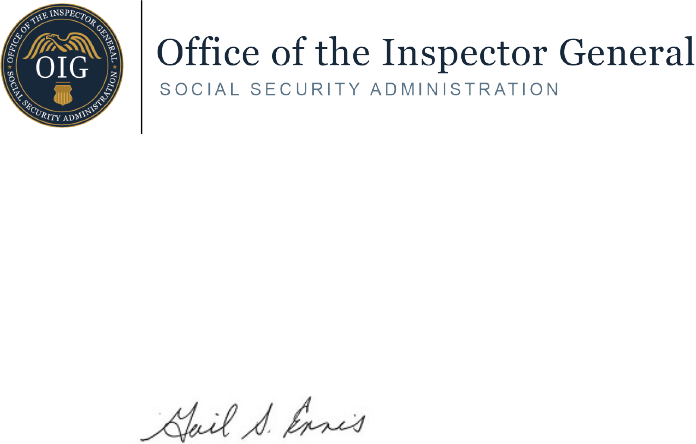
Audit Report
Processing Non-citizens’ Original
Social Security Numbers
Electronically Through
Enumeration Programs
A-08-22-51136 September 2023

MEMORANDUM
Date:
September 20, 2023
Refer to:
A-08-22-51136
To:
Kilolo Kijakazi
Acting Commissioner
From:
Gail S. Ennis
Inspector General
Subject:
Processing Non-citizens’ Original Social Security Numbers Electronically Through Enumeration
Programs
The attached final report presents the results of the Office of Audit’s review. The objective was
to determine whether the Social Security Administration’s policies and procedures prevented it
from assigning multiple Social Security numbers to non-citizens who applied for original
numbers through the Enumeration at Entry and Enumeration Beyond Entry processes.
Please provide within 60 days a corrective action plan that addresses each recommendation. If
you wish to discuss the final report, please call me or have your staff contact
Michelle L. Anderson, Assistant Inspector General for Audit.
Attachment

Processing Non-citizens’ Original Social Security
Numbers Electronically Through Enumeration Programs
A-08-22-51136
September 2023 Office of Audit Report Summary
Objective
To determine whether the Social
Security Administration’s (SSA)
policies and procedures prevented it
from assigning multiple Social Security
numbers (SSN) to non-citizens who
applied for original numbers through
the Enumeration at Entry (EAE) and
Enumeration Beyond Entry (EBE)
processes.
Background
In Calendar Year (CY) 2021, SSA
assigned approximately 4.9 million
original SSNs. Of those, SSA
assigned approximately 588,000
original SSNs to EAE and EBE
participants.
The EAE program was set up through
a Memorandum of Understanding
(MOU) with the U.S. Departments of
Homeland Security (DHS) and State
(State) to assist SSA in enumerating
non-citizens DHS admitted as lawful
permanent residents.
Likewise, SSA’s MOU with DHS’ U.S.
Citizenship and Immigration Services
provides SSA information necessary to
enumerate non-citizens via the EBE
process for those who qualify.
We reviewed the approximately
4.9 million original SSNs SSA
assigned in CY 2021 to determine
whether SSA assigned multiple SSNs
to non-citizens. We used computer
software to identify potential matches
then manually reviewed to ensure they
were matches.
Results
SSA correctly processed and assigned SSNs to approximately
587,000 (99
.8 percent) non-citizens who applied through EAE and
EBE in CY 2021. However, SSA technicians improperly processed
and assigned multiple SSNs to 1,185 (less than 1 percent) non-
citizens who participated in these processes.
Of the 1,185 multiple SSNs assigned, SSA technicians should
have processed 840 as a request for a replacement card.
However, technicians input the applications in the enumeration
system as original SSN requests. These applications contained
the same first name, alien registration number, and date of birth yet
SSA assigned multiple SSNs.
In addition, for the 1,185 multiple SSNs assigned, the system
alerted technicians there was a potential matching record for
1,027. SSA’s system control also compares the incoming SSN
application information to existing Numident records. If the system
identifies a potential match, it places the application in a pending
status, sends an alert to field office technicians, and provides
information from the existing records. Assigning multiple SSNs to
the same person increases the risk of overpayments to
beneficiaries.
Finally, 65,902 (1.3 percent) of the approximately 4.9 million
original applications received in CY 2021 had “unknown” recorded
in the (1) Mother's Name, (2) Father's Name, and (3) City of Birth
fields. SSA depends on DHS and State to provide the data it
needs to process SSN applications and support the integrity of the
information it retains to ensure an effective enumeration process.
Recommendations
We made five recommendations to SSA, including cross-ref
erring
the 1,185 individuals’ SSN records and enhancing controls on
technician actions and data received via these processes.
SSA agreed with Recommendations 1 and 2 and disagreed with
Recommendations 3 through 5.

Processing Original SSNs Electronically through Enumeration Programs (A-08-22-51136)
TABLE OF CONTENTS
Objective ..................................................................................................................................... 1
Background ................................................................................................................................. 1
Results of Review ....................................................................................................................... 2
Technicians’ Searches for Existing Social Security Number Records .................................... 3
Technicians’ Processing of System Alerts ............................................................................. 4
Enumeration Data Received from the U.S. Departments of Homeland Security and State .... 4
Conclusions ................................................................................................................................ 6
Recommendations ...................................................................................................................... 6
Agency Comments and Office of the Inspector General Response ............................................. 6
– Scope and Methodology .................................................................................. A-1
– Operation Allies Welcome ................................................................................ B-1
– Agency Comments........................................................................................... C-1

Processing Original SSNs Electronically through Enumeration Programs (A-08-22-51136)
ABBREVIATIONS
ARN Alien Registration Number
CY Calendar Year
DHS U.S. Department of Homeland Security
DOB Date of Birth
EAE Enumeration at Entry
EBE Enumeration Beyond Entry
FO Field Office
IOM International Organization for Migration
MOU Memorandum of Understanding
OIG Office of the Inspector General
POMS Program Operations Manual System
SSA Social Security Administration
SSN Social Security Number
State U.S. Department of State

Processing Original SSNs Electronically through Enumeration Programs (A-08-22-51136) 1
OBJECTIVE
To determine whether the Social Security Administration’s (SSA) policies and procedures
prevented it from assigning multiple Social Security numbers (SSN) to non-citizens who applied
for original numbers through the Enumeration at Entry (EAE) and Enumeration Beyond Entry
(EBE) processes.
BACKGROUND
The SSN allows employers to identify and record individuals’ earnings and helps SSA track
earnings, determine eligibility for benefits, and pay correct benefit amounts.
1
SSA also uses the
SSN to monitor an individual’s record once benefits begin. The card issued when SSA assigns
an SSN is called the original card. Subsequent cards issued from the same SSN account are
called replacement cards. In Calendar Year (CY) 2021, SSA assigned approximately 4.9 million
original SSNs: 224,000 to EAE participants and 364,000 to EBE participants.
The EAE program was set up through a Memorandum of Understanding (MOU) with the
U.S. Departments of Homeland Security (DHS) and State (State) to assist SSA in enumerating
non-citizens DHS has admitted as lawful permanent residents. If a non-citizen wishes to apply
for an original or replacement SSN card under EAE, State collects enumeration data during the
non-citizen visa process and electronically transmits the data to DHS.
2
The data elements
collected are the same as those SSA requests from non-citizens when they file for an SSN at an
SSA field office (FO) or card center.
3
Similarly, SSA’s MOU with DHS’ U.S. Citizenship and
Immigration Services
4
provides SSA information necessary to enumerate, through the EBE
process, non-citizens who live in the United States; need to obtain an original SSN or
replacement card; and are applying with either Form I-766, Employment Authorization
Document, or Form I-551, Permanent Resident Card.
5
Under EAE and EBE, DHS electronically transmits to SSA the data it needs to process and
assign SSNs.
6
Once SSA’s enumeration system processes the SSN application data, SSA
mails the SSN card to the address on the application. The EAE and EBE processes eliminate
the need for non-citizens to visit an SSA FO to file applications for original or replacement
SSNs. SSA’s enumeration system has controls in place to determine whether an original SSN
should be assigned.
1
Testimony of Sean Brune, Deputy Commissioner for Systems and Chief Information Officer: Hearing on the Social
Security Administration’s Role in Combatting Identity Fraud Before the House Committee on Ways and Means,
Subcommittee on Social Security, 118
th
Congress p. 1 (2023).
2
SSA, POMS, RM 10205.600, A (September 30, 2020). EAE became effective October 2002 for non-citizens who
are age 18 or older and DHS lawfully admitted at entry into the United States as permanent residents.
3
In this report, FO includes field offices and card centers.
4
For purposes of this report, we use DHS to collectively refer to its services and those under U.S. Citizenship and
Immigration Services when we discuss the administration of the EBE.
5
SSA, POMS, RM 10205.700, A (August 13, 2021). EBE became effective October 2017 for non-citizens who were
applying for an Employment Authorization Document and has since expanded to include applicants for a Lawful
Permanent Resident Card.
6
SSA refers to its enumeration system as the Social Security Number Application Process.

Processing Original SSNs Electronically through Enumeration Programs (A-08-22-51136) 2
SSA’s enumeration system will not process an application for an original SSN if it identifies data
on SSA records that closely match
7
data on the incoming application. Instead, the system
generates an alert that notifies FO technicians there may be existing SSNs that require their
review and resolution before further action can be taken on the application. FO technicians
resolve these alerts by comparing the information from the list of possible SSNs to the incoming
SSN application. If technicians determine the applicant has an SSN, SSA can issue a
replacement SSN card. If the technician does not find an existing SSN record, in most
situations, SSA will assign an original SSN.
We reviewed the approximately 4.9 million original SSNs SSA assigned in CY 2021 to
determine whether SSA assigned multiple SSNs to non-citizens.
8
We used computer software
to identify potential matches then manually reviewed to verify they were matches. We reviewed
data elements including the applicant’s name, date of birth (DOB), alien registration number
(ARN), place of birth, and mothers’ names. We reviewed the data for these matches to
determine whether SSA’s system alerted technicians of potential matches and evaluated the
data SSA received. See Appendix A for more information on our scope and methodology. See
Appendix B for information on SSA’s assistance with SSN cards for non-citizens the
United States admitted under Operations Allies Welcome.
RESULTS OF REVIEW
SSA correctly processed and assigned SSNs to approximately 587,000 (99.8 percent) non-
citizens who applied through EAE and EBE in CY 2021. However, SSA technicians improperly
processed and assigned multiple SSNs to 1,185 (less than 1 percent) non-citizens who
participated in these processes.
9
SSA requires that technicians search for existing SSN records if an individual applies for an
original SSN at an FO. Of the 1,185 multiple SSNs assigned, SSA technicians should have
originally processed 840 as a request for a replacement card.
10
There was enough similar
matching information between incoming FO applications and existing SSN records. However,
technicians input the applications into the enumeration system as original SSN requests. For
example, one EBE application showed the applicant’s last name as “Perez Ramirez,” but the
SSA office application showed the last name as “Perez.” For these applications, the
applications contained the same first name, ARN, and DOB, yet SSA assigned multiple SSNs.
7
When the enumeration system generates an alert, it lists the potential matches, which includes the numberholders’
identifying information in SSA’s records. This is designed to prevent issuing multiple SSNs to the same non-citizen.
8
In SSA’s May 2023 evaluation of Multiple SSNs Assigned via EBE Workload, SSA reviewed Fiscal Years 2021
through 2022. SSA’s review included all our audit population in its review.
9
Before our review, SSA identified an additional 311 non-citizens with multiple SSNs assigned in CY 2021 and cross-
referenced their information in its records. Additionally, in SSA’s May 2023 evaluation of Multiple SSNs Assigned via
EBE Workload, SSA identified 3,336 cases from the EBE process where SSA potentially assigned 2 SSNs to the
same person. Of the 3,336 cases SSA identified, we identified 638 as having more than 1 SSN assigned.
10
SSA could not identify the remaining 345 non-citizens because the second application was not filed at an FO.

Processing Original SSNs Electronically through Enumeration Programs (A-08-22-51136) 3
SSA’s system also compares the incoming SSN application information to existing Numident
records. If the system identifies a potential match, it places the application in a pending status,
sends an alert to FO technicians, and provides information from the existing records. For the
1,185 multiple SSN assignments, the system alerted technicians there was a potential matching
record for 1,027. Assigning multiple SSNs to the same person increases the risk of
overpayments to beneficiaries.
SSA depends on DHS and State to provide the data it needs to process SSN applications and
support the integrity of the information it retains to ensure an effective enumeration process.
We observed 65,902 (1.3 percent) of the approximately 4.9 million original applications received
in CY 2021 had “unknown” recorded in the (1) Mother's Name, (2) Father's Name, and (3) City
of Birth fields. Additionally, SSA’s enumeration system did not recognize matches for 158 non-
citizens who received multiple SSNs because key data fields in the applications and established
enumeration records were dissimilar.
Technicians’ Searches for Existing Social Security Number
Records
FO technicians did not find that an SSN record existed for 840 (71 percent) of the 1,185 non-
citizens whom SSA assigned multiple SSNs. The 840 non-citizens applied for an SSN through
EAE or EBE and later visited an FO. When an individual applies for an SSN at an FO, SSA
technicians must verify their identity and determine whether SSA has previously assigned them
an SSN.
SSA’s EAE policy instructs technicians to search for the applicant’s name and DOB via
Alpha-Index
11
12
queries to avoid assigning multiple SSNs.
SSA’s EBE policy instructs technicians to search by name and DOB via ALPHIDENT
query.
SSA instructs technicians to search by the name and DOB via Alpha-Index when an in-
person interview is required for an SSN.
13 14
Of the 840 non-citizens, 788 (94 percent) had matching ARNs on both SSN applications
(1 application submitted via EAE or EBE and the other at an FO). The remaining 52 non-
citizens had matching, or closely matching, names and/or dates of birth. We believe a revision
to policy that ensures technicians first search non-citizens’ ARN via ALPHIDENT to identify
existing SSN records could reduce instances where multiple SSNs are assigned. If the ARN
search produces no matches, SSA should require an Alpha-Index query by name and DOB.
This would allow the technician to quickly determine that a non-citizen already has an assigned
SSN and should be issued a replacement SSN card.
11
Non-citizens applying via EAE typically present evidence of identity via a Machine Readable Immigrant Visa with
temporary I-551 language evidencing permanent residence for 1 year or an I-551 Permanent Resident Card. SSA,
POMS, RM 10205.600, C (September 30, 2020) and RM 10211.025, C.2 (September 10, 2021).
12
The Alpha-Index is an online query request screen that searches SSA’s master file.
13
Non-citizens applying via EBE typically present evidence of identity via Form I-766, Employment Authorization
Document. SSA, POMS, RM 10205.700, C (August 13, 2021).
14
This Web-based query searches by name and DOB, ARN, or Birth Certificate Number if the SSN is unknown.

Processing Original SSNs Electronically through Enumeration Programs (A-08-22-51136) 4
Technicians’ Processing of System Alerts
FO technicians also improperly cleared system-generated alerts for 1,027
15
(87 percent) of the
1,185 non-citizens. When SSA's enumeration system identifies information on an incoming
SSN application, matches, or closely matches, information in SSA’s Numident,
16
it places the
application in a pending status and alerts technicians to review the potential matches to
determine whether an original or replacement SSN card should be issued. For these
1,027 non-citizens, there was enough similar information between records that technicians
should have recognized the established SSN record and application data belonged to the same
non-citizen and issued a replacement card instead of assigning an original SSN.
Technicians’ failure to thoroughly review the potential matching SSNs the system identified
resulted in SSA improperly clearing alerts and assigning a second SSN. Technicians
improperly clearing these alerts continues to be a finding in our enumeration audits.
17
Multiple
SSNs create a risk of improper payments. For example, in a prior audit, we determined SSA
improperly paid approximately $46.9 million to 724 beneficiaries who received benefits under
multiple SSNs for various reasons including individuals using multiple SSNs, identity theft, and
administrative errors.
18
To reduce multiple SSN assignments caused by technicians improperly
clearing alerts, SSA should implement a control to ensure employees follow policy when they
clear alerts that would result in the system assigning individuals another SSN or other control to
prevent the assignment of multiple SSNs.
Enumeration Data Received from the U.S. Departments of
Homeland Security and State
SSA’s enumeration system uses DHS and State information to assign SSNs to EAE and EBE
participants. An addendum to the MOU between SSA and DHS states the applicant’s city of
birth and parents’ names are required fields;
19
however, in the EBE process, SSA allows the
system to accept “unknown” in these fields. Of the approximately 4.9 million enumeration
records from CY 2021, 65,902 (1.3 percent) original applications had “unknown” in the
(1) Mother's Name, (2) Father's Name, and (3) City of Birth fields.
20
Only 29 of these
applications were completed in SSA offices, and 65,873 (greater than 99.9 percent) were
completed through the EBE process.
15
Of the 1,027 EMs generated, 952 had matching ARNs on the FO application and the previously established SSN
record.
16
The Numident houses the identifying information for each individual who is assigned an SSN.
17
SSA, OIG, Multiple Social Security Numbers Assigned to Non-citizens Using the Enumeration Beyond Entry
Program, A-08-18-50472, p. 3 (December 2019); Follow-Up: Assessment of the Enumeration at Entry Process,
A-08-07-17143, p. 5 (March 2008); and Assessment of the Enumeration at Entry Process, A-08-04-14093, p. 4
(March 2005).
18
SSA, OIG, Follow-up: Individuals Who Inappropriately Received Benefits Under Multiple Social Security Numbers,
A-01-16-50075, pp. 2 and 4 (April 2019).
19
Addendum to Memorandum of Understanding Between the Social Security Administration and the Immigration and
Naturalization Service (Department of Homeland Security) (U.S. Citizenship and Immigration Services), DHS, SSA,
June 14, 2021.
20
We notified DHS’ Inspector General to this problem with the data SSA received from DHS.

Processing Original SSNs Electronically through Enumeration Programs (A-08-22-51136) 5
SSA requested DHS collect and provide these data elements as agreed, but this has not
resolved the problem with recording “unknown” for applicants’ city of birth and/or parents’
names. SSA considers the name, DOB or age, gender, and parents’ names helpful in
establishing applicants’ identity. SSA’s continued acceptance of “unknown” when the
information is available could affect its employees’ resolution of alerts, which could result in
multiple SSN assignments.
Additionally, SSA’s enumeration system did not recognize matches for 158 non-citizens who
received multiple SSNs. This occurred because key data fields from their applications and
established enumeration records were dissimilar. For example, the ARNs for 155 (98 percent)
of these non-citizens’ enumeration records did not match. We identified occurrences where
DHS entered non-citizens’ first, middle, and/or last name fields differently from that on SSA’s FO
application. For example, one EBE application showed the applicant’s last name as “Franco
Gomez,” but the FO application showed the last name as “Franco.” We also observed
instances where a non-citizen’s DOB month and day were reversed. Such discrepancies
prevented SSA’s enumeration system from identifying possible matches and generating alerts.
The enumeration system cannot determine whether an applicant may already be assigned an
SSN and generate an alert when there is not enough matching, or closely matching, information
on the new application and a previously established SSN record.
The MOU SSA and State signed in 1996 and the addendum to the MOU SSA and DHS signed
in 2021 identify the data fields to collect and transmit to SSA, but there is no indication on how
the requirements were communicated to DHS and State employees who collect the data. SSA
needs to update these MOUs to ensure they have quality review programs and provide accurate
data, when available. Additionally, updating the MOUs to include annual training of DHS and
State employees on the information required could help SSA in preventing individuals from
receiving multiple SSNs and safeguard the integrity of SSA’s Numident.
We asked SSA to provide information on the quality reviews it performed on the data received
through EAE and EBE and information on its evaluation of the controls in place at DHS and
State to ensure the integrity of the data and process. SSA provided its last review of
enumeration accuracy that included a review of EAE for Fiscal Year 2015. Additionally, SSA
evaluated multiple SSNs assigned via the EBE workload. Implementing a quality review plan at
SSA to monitor the enumeration data received through EAE and EBE would provide SSA with
information on discrepancies. This information would further allow SSA to provide focused
training to promote DHS and State employees’ understanding of the data requirements.

Processing Original SSNs Electronically through Enumeration Programs (A-08-22-51136) 6
CONCLUSIONS
SSA’s policies and processes primarily led to the assignment of only one original SSN to
individuals applying through the EAE and EBE processes. However, we found less than
1 percent of situations where technicians improperly assigned a second SSN for a person who
applied through the EAE and EBE processes. Additionally, SSA continues to receive
incomplete information via EAE and EBE. Although we only found a small number of individuals
who received a second SSN, this causes additional work for SSA employees and increases the
risk that those multiple SSNs will lead to improper payments or fraudulent activity.
RECOMMENDATIONS
We recommend SSA:
Cross-reference the 1,185 non-citizens’ records with multiple SSNs. (We will provide these
SSNs under separate cover.)
Revise policy to require that technicians conduct additional research for existing SSN
records of non-citizens.
Implement a control to ensure employees follow policy when they clear alerts that result in
improper assignment of SSNs.
Work with DHS and State to update the MOUs to include a quality review program that
ensures accurate data are provided. Additionally, the MOUs should include training of DHS
and State employees, when needed.
Design and implement a quality review plan to monitor the enumeration data received via
EAE and EBE and develop training for DHS and State employees based on the inaccurate
enumeration data.
AGENCY COMMENTS AND OFFICE OF THE INSPECTOR GENERAL
RESPONSE
SSA agreed with Recommendations 1 and 2 but disagreed with Recommendations 3 through 5.
Regarding Recommendation 3, SSA stated “OIG reports that our existing business processes
have an error rate of 0.2 percent when assigning SSNs through EAE and EBE. This low error
rate indicates that we have integrity checks and processes in place.” While the error rate is
small, these errors lead the individuals to receive a second SSN, which then requires that SSA
cross-reference these numbers to the one individual. We have published multiple reports in the
past showing where cross-referenced SSNs lead to additional work for SSA and increases the
risk of improper payments and fraudulent activity.
For Recommendation 4, SSA stated “. . . DHS and State collect information in the normal
course of their business and send us the data necessary to assign SSNs to qualified individuals.
As part of our ongoing efforts to improve EAE and EBE, we will continue to emphasize with
DHS and State the need to receive parental data when available.” We continue to believe SSA
should include a quality review program in its MOUs with DHS and State. SSA depends on
DHS and State to provide the data it needs to process an SSN application and permits these

Processing Original SSNs Electronically through Enumeration Programs (A-08-22-51136) 7
agencies to record unknown in such fields as Mother's Name, Father's Name, and City of
Birth. While permitting agencies to record unknown does not interrupt SSA’s enumeration
process, it affects the integrity of SSA’s Numident and internal processes. Ultimately, a quality
review program and training, where needed, would identify issues that affect the quality of data
received.
For Recommendation 5, SSA stated “. . . DHS and State collect information in the normal
course of their business and send us the data necessary to assign SSNs to qualified individuals.
Receipt of ‘unknown’ for non-critical elements does not make the data inaccurate.” While we
did not determine whether DHS or State could have done a better job at ensuring they collect
data for all fields, our findings show not having this information is one of the causes of a person
receiving a second SSN. While, SSA considers certain fields, such as parent names, “non-
critical” and permits “unknown” in these data fields, we disagree with SSA’s process. Assigning
multiple SSNs is a preventable error. SSA allowing “unknown” in its data fields makes it less
likely employees will recognize multiple SSN assignment, which ultimately affects the integrity of
SSA’s Numident and enumeration business process.
See Appendix C for the full text of the Agency’s comments.
Mic
helle L. Anderson
Assistant Inspector General for Audit

Processing Original SSNs Electronically through Enumeration Programs (A-08-22-51136)
APPENDICES

Processing Original SSNs Electronically through Enumeration Programs (A-08-22-51136) A-1
– SCOPE AND METHODOLOGY
To accomplish our objective, we:
• Reviewed the approximately 4.9 million original Social Security numbers (SSN) the Social
Security Administration (SSA) assigned in Calendar Year 2021 to determine whether SSA
assigned multiple SSNs to non-citizens who applied for an SSN via the Enumeration at
Entry
1
(EAE) or Enumeration Beyond Entry (EBE) processes. We initially searched for
matches using computer software, then we manually reviewed to ensure they were
matches. We identified 1,185 matches that were not cross-referenced in SSA’s records.
• Determined whether SSA’s system generated an Enumeration Feedback Message to alert
SSA technicians there was similar information in SSA records that matched the application
for the 1,185 non-citizens we identified SSA assigned multiple SSNs and whether SSA
technicians processed these alerts correctly.
• Evaluated the data submitted electronically via the EAE and EBE processes and whether
there were additional data not transmitted that would benefit SSA.
• Determined whether SSA conducted quality reviews of the data received via EAE and EBE
or evaluated the controls in place at the U.S. Departments of Homeland Security and State
to ensure the integrity of the data and the process.
2 3
W
e conducted our audit in Birmingham, Alabama, from September 2022 to June 2023. We
assessed the reliability of the enumeration data by (1) reviewing related documentation from
relevant prior audits, (2) looking for duplicate records, (3) comparing our record count to the
expected record count, (4) tracing a statistically random sample of data to source documents,
(5) testing for values outside of a designated range, (6) looking for dates outside of the audit
scope of Calendar Year 2021, and (7) reviewing the data for unexpected aspects, such as
sensitive or confidential records. As a result, we determined the data were sufficiently reliable
for the purposes of responding to our objective.
1
The SSN allows employers to identify and record individuals’ earnings and helps SSA track earnings, determine
eligibility for benefits, and pay correct benefit amounts. Testimony of Sean Brune, Deputy Commissioner for Systems
and Chief Information Officer: Hearing on the Social Security Administration’s Role in Combatting Identity Fraud
Before the House Committee on Ways and Means, Subcommittee on Social Security, 118
th
Congress p. 1 (2023).
SSA also uses the SSN to monitor the individual’s record once benefits begin. The card issued when SSA assigns
the SSN is called the original card. Subsequent cards issued from the same SSN account are called replacement
cards.
2
SSA, POMS, RM 10205.600, A (September 30, 2020). SSA has agreements with the U.S. Departments of
Homeland Security and State to assist SSA in enumerating non-citizens who request an SSN via the EAE process.
EAE became effective October 2002 for non-citizens age 18 or older and lawfully admitted entry into the
United States as permanent residents by the U.S. Department of Homeland Security.
3
SSA, POMS, RM 10205.700, A (August 13, 2021). EBE became effective October 2017 for non-citizens who were
applying for an employment authorization document and has since expanded to include applicants for Lawful
Permanent Residency. SSA has an agreement with the U.S. Department of Homeland Security’s U.S. Citizenship
and Immigration Services for those non-citizens requesting an SSN via the EBE process.

Processing Original SSNs Electronically through Enumeration Programs (A-08-22-51136) A-2
We assessed the significance of internal controls necessary to satisfy the audit objective. This
included an assessment of the five internal control components, including control environment,
risk assessment, control activities, information and communication, and monitoring. In addition,
we reviewed the principles of internal controls associated with the audit objective. We identified
the following component and principles as significant to the audit objective.
Component 3: Control Activities
Principle 10: Design Control Activities
Principle 12: Implement Control Activities
Component 4: Information and Communication
Principle 15: Communicate Externally
Component 5: Monitoring
Principle 16: Perform Monitoring Activities
The primary entity audited was the Office of the Deputy Commissioner for Operations. We
conducted this performance audit in accordance with generally accepted government auditing
standards. Those standards require that we plan and perform the audit to obtain sufficient,
appropriate evidence to provide a reasonable basis for findings and conclusions based on our
audit objective. We believe the evidence obtained provides a reasonable basis for our findings
and conclusions based on our audit objective.

Processing Original SSNs Electronically through Enumeration Programs (A-08-22-51136) B-1
– OPERATION ALLIES WELCOME
In the summer 2021, the United States began admitting non-citizens from Afghanistan as part of
Operation Allies Welcome. The Social Security Administration (SSA) processed the Social
Security number (SSN)
1
applications for these non-citizens through the Enumeration Beyond
Entry (EBE) process.
2
Generally, once an application for an SSN card is processed, the card is
mailed to the address the applicant provided.
3
However, under a process unique to Operation
Allies Welcome, SSA mailed SSN cards to a centralized address at the International
Organization for Migration (IOM), a non-governmental agency that assisted Afghan nationals
with resettlement.
4
These non-citizens did not have permanent addresses when they entered
the United States.
IOM received the SSN cards from SSA and the Employment Authorization Documents from the
U.S. Department of Homeland Security (DHS) and forwarded them to the non-citizens’ new
locations/addresses once they were established. According to SSA, it was not involved in the
decision-making process to use IOM to receive and distribute the SSN cards. SSA took
possession of about 38,000 SSN cards that IOM could not deliver to the applicants. SSA
worked with DHS’ U.S. Citizenship and Immigration Services and IOM to improve the tracking
capability, security, and mailing of SSN cards.
1
The SSN helps SSA identify and accurately record wages or self-employment earnings. SSA also uses the SSN to
monitor the individual’s record once benefits begin.
2
EBE became effective October 2017. The EBE program was set up through a Memorandum of Understanding with
the U.S. Department of Homeland Security’s U.S. Citizenship and Immigration Services to provide SSA information
necessary to enumerate those non-citizens who live in the United States; need to obtain original an SSN or
replacement card; and are applying with either Form I-766, Employment Authorization Document, or Form I-551,
Permanent Resident Card. The data elements collected are the same as those SSA requests from non-citizens
when they file for an SSN at an SSA field office or card center.
3
SSA, POMS, RM 10205.700, A (August 13, 2021).
4
SSA provided multiple instructions to assist with enumerating Afghan Special Immigrant Visa holders and
refugee/asylees.

Processing Original SSNs Electronically through Enumeration Programs (A-08-22-51136) C-1
– AGENCY COMMENTS
SOCIAL SECURITY
MEMORANDUM
Date:
August 30, 2023 Refer To: TQA-1
To:
Gail S. Ennis
Inspector General
From:
Scott Frey
Chief of Staff
Subject:
Office of the Inspector General Draft Report, “Processing Non-citizens’ Original Social
Security Numbers Electronically Through Enumeration Programs” (A-08-22-51136) -
INFORMATION
Thank you for the opportunity to review the draft report. Please see our detailed
comments in the attached document.
Please let me know if I can be of further assistance. You may direct staff inquiries to
Trae Sommer at (410) 965-9102.
Attachment

Processing Original SSNs Electronically through Enumeration Programs (A-08-22-51136) C-2
SSA COMMENTS ON THE OFFICE OF INSPECTOR GENERAL DRAFT REPORT
“PROCESSING NON-CITIZENS’ ORIGINAL SOCIAL SECURITY NUMBERS
ELECTRONICALLY THROUGH ENUMERATION PROGRAMS” (A-08-22-51136)
GENERAL COMMENTS
As shown in the report, our existing systems and policies ensure a high level of accuracy
(99.8 percent) when we assign Social Security numbers (SSN) for non-citizens. We continue to
engage with the Department of Homeland Security (DHS) and the Department of State (State) to
improve and expand Enumeration at Entry (EAE) and Enumeration Beyond Entry (EBE).
Our responses to the recommendations are below.
Recommendation 1
Cross-reference the 1,185 non-citizens’ records with multiple SSNs. (We will provide these
SSNs under separate cover.)
Response
We agree.
Recommendation 2
Revise policy to require that technicians conduct additional research for existing SSN records of
non-citizens.
Response
We agree.
Recommendation 3
Implement a control to ensure employees follow policy when they clear alerts that results in
improper assignment of SSNs.
Response
We disagree. OIG reports that our existing business processes have an error rate of 0.2 percent
when assigning SSNs through EAE and EBE. This low error rate indicates that we have
integrity checks and processes in place.

Processing Original SSNs Electronically through Enumeration Programs (A-08-22-51136) C-3
Recommendation 4
Work with DHS and State to update the MOUs to include a quality review program that ensures
accurate data are provided. Additionally, the MOUs should include training of DHS and State
employees, when needed.
Response
We disagree. DHS and State employees do not enter or process information specifically for
enumeration. Rather, DHS and State collect information in the normal course of their business
and send us the data necessary to assign SSNs to qualified individuals. As part of our ongoing
efforts to improve EAE and EBE, we will continue to emphasize with DHS and State the need to
receive parental data when available.
Recommendation 5
Design and implement a quality review plan to monitor the enumeration data received via EAE
and EBE and develop training for DHS and State employees based on the inaccurate
enumeration data.
Response
We disagree. DHS and State employees do not enter or process information specifically for
enumeration. Rather, DHS and State collect information in the normal course of their business
and send us the data necessary to assign SSNs to qualified individuals. Receipt of "unknown"
for non-critical elements does not make the data inaccurate.

Mission: The Social Security Office of the Inspector General (OIG) serves the
public through independent oversight of SSA’s programs and operations.
Report: Social Security-related scams and Social Security fraud, waste, abuse,
and mismanagement, at oig.ssa.gov/report.
Connect: OIG.SSA.GOV
Visit our website to read about our audits, investigations, fraud alerts,
news releases, whistleblower protection information, and more.
Follow us on social media via these external links:
Twitter: @TheSSAOIG
Facebook: OIGSSA
YouTube: TheSSAOIG
Subscribe to email updates on our website.
